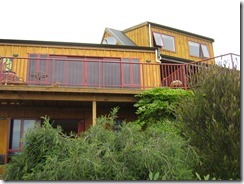On my Energy Issues page I mentioned some research that we did to find out about going off-the-grid for all our power. The challenges became so daunting (and expensive) we gave it away, however, now we are about to go solar for our water heating.
It really does pay to talk to experts because they do have some practical passive energy solutions that the average homeowner (I include myself in that group) wouldn’t think about. We had always gazed skyward and had seen our steeply sloping roof as ideal for panels. Panel dimensions, however, turned out to be too large for the space where we planned. They would have to go across part of the upper windows (see photo) to get the optimum slope.
The installer we talked to suggested that the panel(s) be positioned in front of our deck (the deck on the right not in the picture) . The panel would be unseen when we were on our deck or from inside; the installation would not compromise the integrity of our roof; and being a retro-install we would not have to cut into walls to link up to the current position of the water heater.
We will have to move a few plants – a couple that will now be behind the panel, and one that will cast a shadow over the panel. Having a house built at the top of a slope has helped because we will not be built out or have trees in lower properties grow too tall.
So now we’re preparing the site. We won’t be able to do a straight comparison of costs as we generally turn off the water heater unless we have guests. Instead we use a system of gas water heating. The installer’s proposal is that we will have a dual system. When solar energy is low and the water temperature drops we will be able to switch back to gas heating, and vice versa.
I think it’s natural to think that solar panels have to be placed on the roof. It always seems to be the place nearest the sun. We have since researched a number of ways they can be positioned if the house roof is not ideal. They can be placed behind the house, raised above sheds, or placed on fences. In fact YouTube has a great selection of systems to copy.
If you’re really interested in doing some of the process yourself take a look at these YouTube videos –
- Panels mounted on a wooden frame.
- Panels on a fence using shelf brackets.
- A Cape Town guy measures and compares Monocrystalline vs Polycrystalline: Effect of temperature on output performance / power over several videos.
By Heather Sylvawood, author of Real Estate Rollercoaster – what the professionals forget to tell you about buying, building and selling real estate.

